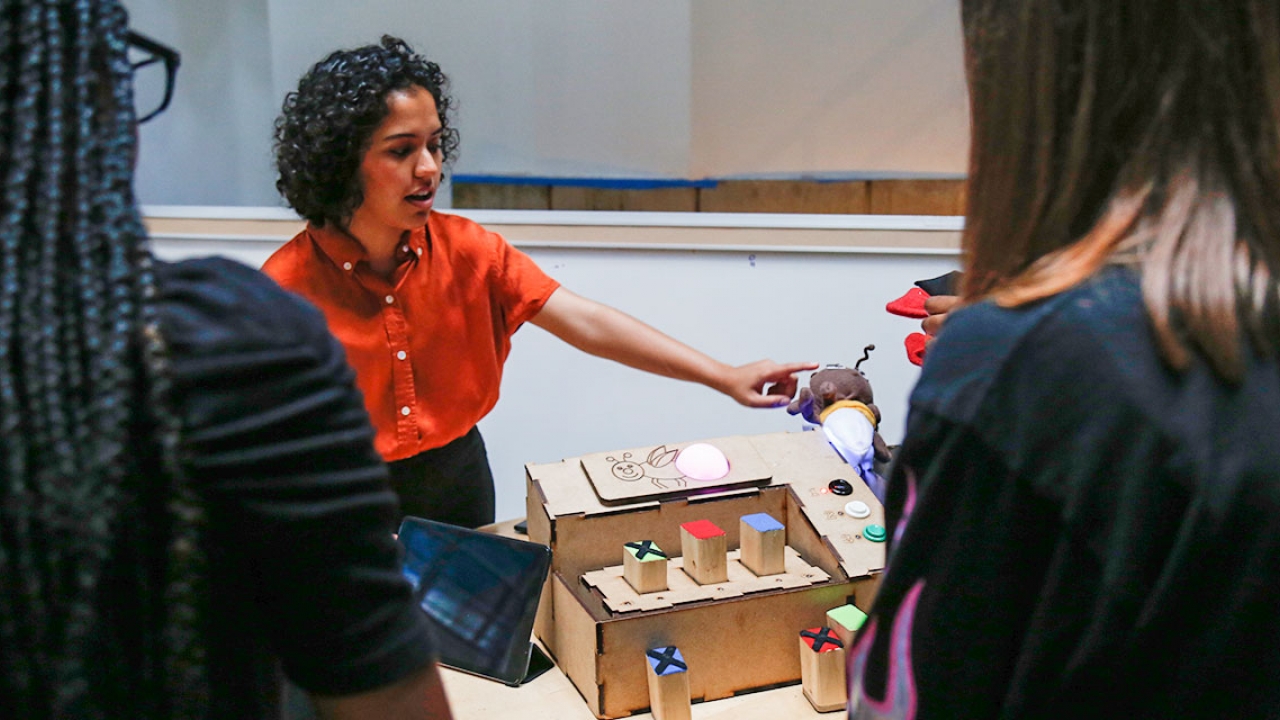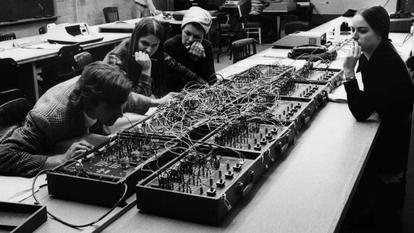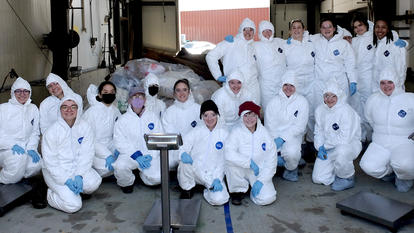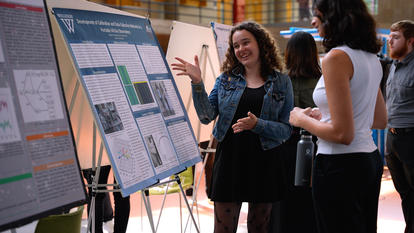Celebrating a Summer of Science Research at Wellesley

Wellesley College students and faculty marked the culmination of the Science Center Summer Research program at the annual poster session on Thursday, August 2. This year, 116 students and 44 faculty members participated in the program. Michelle Callahan, senior project engineer from Nitsch Engineering gave the keynote at the event.
The Daily Shot caught up with some of the students involved with the projects to learn more about their findings and experiences.
Angie the Angler fish teaches kids about bioengineering, ethics
Jennifer Otiono ’18, Parul Koul ’19, Trisha Garcia DS ’19, and Zoe Allen ’21 believe that when it comes to science curriculum in elementary schools, young students need more opportunities to learn the concepts, and ethics, of bioengineering earlier. They developed “Crispee,” a multi-touch, tangible game that children can play to learn about genes, alleles, and how certain traits are expressed depending on combinations. For example, players can make Angie the Angler fish’s angler light up with a certain color combination through the correct sequence of wooden blocks, the “on” or “off” alleles in genes. It also helps children learn about primary colors – if the “on” blocks for alleles that are blue and red are selected, the light will be purple. Additionally, the team also developed a tablet-based game to teach about bioethics, with Angie leading a narrative about the potential (and sometimes unintended) consequences of bioengineering. The team, part of Wellesley’s Human Computer Interaction Laboratory, will now work with collaborators at Tufts University’s DevTech Lab to get feedback and observations from children this fall, and plans to submit a working paper about their research as well.
To study phytoplankton, take to the sea
Off the coast of Iceland, Emma Jackman ‘19, spent three weeks on a research vessel working with Wellesley professor Hilary Palevsky studying the productivity of phytoplankton – quite a change from her previous work at Wellesley (on land) in soil science. During the spring bloom, phytoplankton “go crazy,” she said, and by collecting data from surface water, they were able to determine where phytoplankton were more productive. They found that in western areas of the Irminger Sea, there was increased productivity, likely because of shallower and thus slightly warmer waters. Because phytoplankton can help take in carbon dioxide from the atmosphere and regulate the global carbon cycle, knowing about their productivity and mechanisms can help to inform our knowledge of climate change and development of environmental policy.
How songbirds learn their songs
For Taylor Burke ’20 and Lillian Sall ’21, discovering how songbirds learn may be an early step towards greater understanding of how humans acquire language and vocalize. In the wild, baby birds typically learn songs from their fathers. For this experiment, Burke and Sall gave baby zebra finches the opportunity to learn from one “tutor.” Then, they introduced a new “tutor” as the birds’ source of sounds and songs. Through listening to recordings, they found that the birds’ songs were more similar to the second tutor. And when they analyzed the recordings further, looking at the pitch and frequency of the sounds, for example, the team did notice similarities between what the birds learned from their first tutor and what they learned from their second—showing that they retained some of their earliest “language” learning, despite a new teacher. The team plans to continue their work with professor Sharon Gobes to further develop a deeper understanding of the neural mechanisms of learning and memory.
Gut microbiomes in infants
Danielle Peterson ’20 has done research with the gut microbiome—the diverse and dynamic community of bacteria in the gastrointestinal tract –- since high school, but this summer was the first time she got to work with a large clinical cohort, and combine her experiences in biology with computer science. Her summer research project in collaboration with the Advanced Baby Imaging Lab at Brown University gave her the opportunity to use what she learned in computer science classes at Wellesley in a seven-year longitudinal study exploring the links between the environment, gut microbiome, and infants’ cognitive development. Peterson’s work included analyzing the first batch of data from the study and also developing a pipeline to automate future analysis. She also collaborated with Lauren Tso ’20, Wellesley professor Vanja Klepac-Ceraj, and Dr. Kevin Bonham, a postdoc at Harvard T.H. Chan School of Public Health. Peterson plans to continue work on this project in her remaining two years at Wellesley.
Photo: Parul Koul ’19 explains her project "Crispee," a multi-touch, tangible game that children can play to learn about genes, alleles, and how certain traits are expressed depending on combinations. This summer she worked with three other Wellesley students to come up with a curriculum that will help elementary school students learn the concepts, and ethics, of bioengineering.



